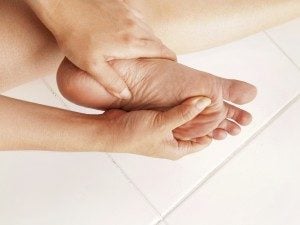
Plantar Fasciitis Exercises

A common cause for athletes to develop heel and foot problems is that many of us exercise in worn out or ill-fitting shoes. The padding in shoes wear out so it is best to get new shoes every 4 to 6 months depending on how often you use them. You may have to replace them sooner if the tread or heels show signs of wear. Buying new shoes can be expensive, but it is less costly; and must less painful; than developing an enduring foot problem. You can also take some other common-sense precautions when training. Avoid running or walking on hard or uneven surfaces. Take a break from exercises that put a lot of stress on your feet and try some activities like swimming or biking. This can help stop plantar fasciitis from appearing or coming back.
If you wish to succeed at treating plantar fasciitis, you should remember the following things:
- Consistency and patience are central to the treatment of plantar fasciitis. Most cases of plantar fasciitis don’t go away right away but they will if you consistently wear good shoes, rest your feet, and stretch regularly.
- Don’t ignore the pain. It will not just go away on its own. Start treatment as soon as possible. The longer you put off treatment, the longer your recovery will take.
Plantar Fasciitis Exercises
1. Toe Curls And Marble Pick Up
These two workouts can help you strengthen your muscles while increasing ligament flexibility. You can do either of these workouts because they both follow the same process.
Sit in a chair and place a towel on the floor to do toe curls. Try picking up the towel with your toe instead of lifting your foot. It should be done five times per day.
Marble pickup is similar to toe curling in that you place marbles on the floor and try to pick them up with your toe. Also, do it five times a day.
2. Rolling Stretch
If you find workouts dull, this one will alter your view because it is a relaxing massage, and there must be no one who does not enjoy massage, therefore anyone can do it.
To do this exercise, sit comfortably in a chair and place a tennis ball on the ground. Gently roll the tennis ball under your foot back and forth for a few minutes, then repeat with the other foot. 2 times daily, repeat for 3-4 minutes.
If you don’t have a tennis ball, you can use any round item such as a golf ball or a water bottle. You can also aid yourself by using a frozen water bottle.
3. Calf Stretching
When you get out of bed, the most typical sign of plantar fasciitis is severe heel discomfort. Because your plantar fascia tightens at night, when you try to walk in the morning, the ligament is suddenly stretched, causing pain.
Our first exercise focuses on resolving this issue so that you don’t have to deal with pain right away when you wake up.
All you have to do is wrap yourself in a towel or a belt before getting out of bed.
Maintain a straight leg and gently pull it towards your body until the lower half of your leg stretches. Hold for 30 seconds before taking your first step out of bed and repeat.
Can orthotic inserts complement plantar fasciitis exercises?
Yes, orthotic inserts can complement plantar fasciitis exercises as part of a comprehensive approach to managing the condition. Here’s how:
- Support and Alignment: Orthotic inserts provide additional support to the arch of the foot and help align the foot and ankle. This can reduce strain on the plantar fascia during weight-bearing activities.
- Shock Absorption: Quality orthotic inserts often have shock-absorbing properties, which can help reduce the impact on the foot, especially during activities like walking or running.
- Pressure Redistribution: Orthotics can redistribute pressure across the foot, alleviating specific areas of strain and helping to prevent excessive stress on the plantar fascia.
- Improved Foot Function: Orthotic inserts can enhance foot function by promoting a more natural gait and distributing forces more evenly, which can be beneficial for individuals with plantar fasciitis.
Can plantar fasciitis exercises be done at home, or is supervision recommended?
Plantar fasciitis exercises can be done at home, and many individuals find success in managing their symptoms through a consistent and well-structured exercise routine. However, the suitability of at-home exercises depends on the severity of the condition, individual health factors, and the specific exercises chosen.
Here are some general guidelines:
- Basic Stretching Exercises: Simple stretching exercises for the calf muscles, Achilles tendon, and the plantar fascia can often be done at home. These exercises aim to improve flexibility and reduce tension in the affected areas.
- Strengthening Exercises: Strengthening exercises for the foot and ankle muscles can be incorporated into a home exercise routine. These may include toe-tapping, towel curls, and other exercises to improve foot strength and stability.
- Massage and Self-Massage Techniques: Techniques such as rolling a tennis ball or frozen water bottle under the foot can be done at home to massage the plantar fascia and relieve tension.
The recovery process will take time. It can take just two to four months or up to a year. The good news is that most sufferers will start to experience less pain within a few weeks of initiating their treatment. If you are one of the small percentage of people who does not improve after using these treatments for 6 to 8 weeks, talk to your healthcare provider. He or she might be able to recommend other treatments.
